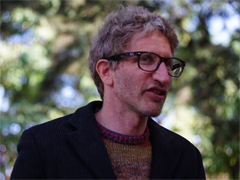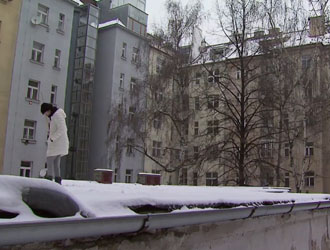Sprawling suburbs of one-family homes and private cars were the chief sets on the stage of the American dream. Going back to a time when fuel was abundant and cheap, they gave rise to a lifestyle that has turned out to be increasingly unsustainable. What will happen to all this when fossil fuels run out?
After the Second World War, the phenomenon of “suburbanism”, spurred on by the popularisation of the private vehicle, became the paradigmatic American dream, thus spreading a residential monoculture that bore no relation to traditional urban structures. The End of Suburbia shows an automobile- and hence oil-dependent, model of urban growth, drawing attention to the underlying political consequences. The documentary claims that this model is doomed to imminent failure because of resource depletion if the influential Hubbert Peak Theory turns out to be correct. This predicts that extractable crude oil reserves will be depleted by 2020.
The film does not go into the spatial, architectural and social aspects of the model as the Canadian documentary Radiant City (by Jim Brown and Gary Burns, 2006) did, although it does offer a brief outline of the historical origins of sprawl using carefully selected archive images. The fact is that – whether it was because of a mistaken interpretation of the social components of the garden city initiated by Ebenezer Howard, or excesses of US patriotism in opting for promoting investment and employment through the Federal Housing Administration and benefits programmes for Second World War veterans, or pressure from the automobile industry and oil companies, or a deliberate plan to alienate the middle classes from their civic power and responsibilities by introducing a kind of individualistic housing model that nourished a bucolic idyll of the little house and garden – this model that appeared and multiplied in the United States ended up being exported all over the planet, including to Europe. From Ontario to Shanghai, via Dubai, Mexico, and Madrid, the detached one-family home covers territory like a carpet of private space in which public space is reduced to the minimum width needed to let cars move around and allow for a footpath which, in most cases, is merely token. It is difficult to understand how such a homogenous typology can be reproduced in such different climatic, orographic and cultural contexts.
Perhaps, as happens with junk TV, the suburban city is not so much what “the people” ask for as what is offered to “the people”. Maybe the offer boils down to a view of economic benefits according to which it would be more profitable to construct mass-produced homes on little blocks with no urban value than to take on the complexity of the consolidated city centre. In any case, the suburban imaginary is a source of attraction and repulsion for many film makers. There are quite a lot of films in which the suburb appears as the background or even a main theme of the story. A documentary like The End of Suburbia is nourished by the Prelinger Archives, which offers a host of audiovisual works about the suburbs and the automobile. In high-grossing films like American Beauty (Sam Mendes, 1999) and Edward Scissorhands (Tim Burton, 1990), the inner chaos of the main characters contrasts with the apparently peaceful and perfect appearance of their suburban neighbourhoods. The lives of the characters in series like Desperate Housewives (Marc Cherry, 2004) and Mad Men (Matthew Weiner, 2007) are confined in the same setting. One notable example is The Truman Show (Peter Weir, 1998), which was filmed in Seaside (Florida). Besides being a film set it is a real town, an example of New Urbanism and designed in accordance with criteria of perfection similar to those used for the TV show set where Truman lives. There are even opposite cases where real urban planning seems to have been inspired by a set. This is the case with the town of “Celebration”, a Disney creation and the most saccharine version of American suburbia, which might have been the ideal set for The Stepford Wives (Bryan Forbes, 1975), where the wives of local men, robotised into submission, are pillars of neighbourhood and family harmony.
Nevertheless, just as reality demolished the “Celebration” dream when robberies, sex crimes, murders and wife-swapping reared their ugly heads, it also seems that present-day reality somehow contradicts the thesis of The End of Suburbia. Some people say that the world is not becoming increasingly urban but increasingly suburban. It would therefore seem reasonable to look for ways to make urban fabric denser, to promote public transport, to mingle uses and reinforce public space in order to recover the urbanity of the city. This is what is discussed in the documentary Aprendiendo del New Urbanism (Learning from New Urbanism – with a Spanish title but spoken in English), which comes with the publication Postsuburbia, edited by Zaída Muxí, and also dealt with by Ellen Dunham-Jones (in quite an optimistic fashion) in her TED talk “Retrofitting Suburbia". In contrast with these positions, one finds what could be a Darwinian evolution of the suburb towards the more controversial and perhaps sinister gated community. This is no longer the “ideal” neighbourhood but a whole “gated city” that gives its inhabitants what they need and frees them of worries about extramural violence. Paradoxically, however, even the people responsible for generating this outside violence choose these idyllic neighbourhoods for their own quiet family life. Just like Tony Soprano would do at the end of a day’s work.




